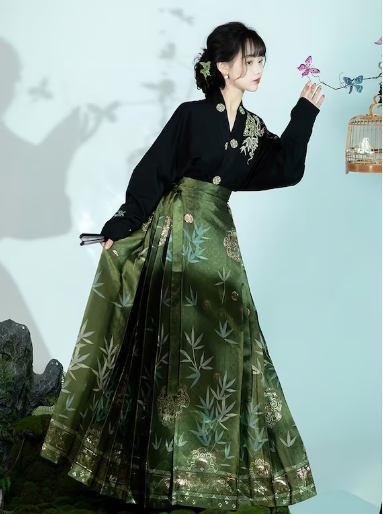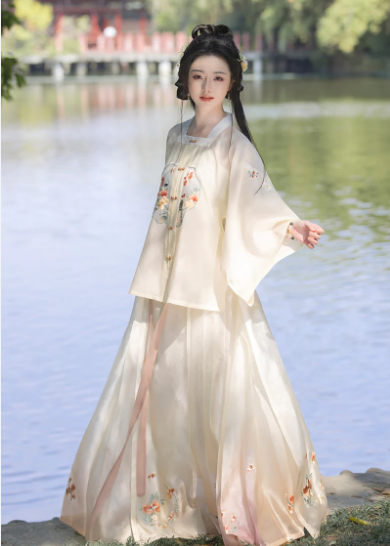Yes, Hanfu can be stylishly adapted for everyday streetwear.
Feasibility of Hanfu as Streetwear
Design Adaptations for Daily Use
Integrating Hanfu into daily streetwear requires innovative design adaptations, ensuring these traditional garments align with modern lifestyles. Designers actively reimagine Hanfu, combining contemporary aesthetics with its historical essence. They focus on simplifying intricate patterns and incorporating user-friendly closures, like buttons or zippers, in place of traditional ties. This approach not only preserves the unique silhouette of Hanfu but also significantly enhances its practicality for everyday wear. The introduction of pockets, a modern element, adds convenience to these traditional outfits.
When it comes to fabric selection, designers favor materials that offer durability and comfort. Modern Hanfu often features a blend of natural and synthetic fibers, creating a perfect balance between maintaining the traditional flow and ensuring easy maintenance. For example, a cotton-polyester blend in Hanfu delivers the elegance of traditional cotton while being less prone to wrinkles and easier to care for.

Weather Suitability and Seasonal Variations
Adapting Hanfu for streetwear also involves tailoring it to different weather conditions and seasons. The traditional silk-based Hanfu doesn’t always suit various weather conditions. To tackle this, designers are now using diverse fabrics suitable for different seasons. For the warmer months, they opt for lighter and more breathable fabrics like linen or thin cotton, ensuring comfort in the heat. Conversely, for the colder months, they use layers of thicker materials like wool to provide warmth.
The Hanfu silhouette undergoes modifications for seasonal suitability. Summer versions often feature shorter sleeves and lighter layers, while winter designs might include longer, thicker coats, maintaining the aesthetic while offering necessary insulation. This versatility not only makes Hanfu more practical as streetwear but also invites wearers to enjoy traditional attire throughout the year.
By addressing design and practicality concerns, Hanfu can evolve from a ceremonial garment to a staple in contemporary wardrobes. With careful consideration of materials, design adaptations, and weather suitability, Hanfu stands as a feasible and stylish option for casual streetwear. This transformation respects the rich cultural heritage of Hanfu and meets the evolving needs of modern fashion enthusiasts.
Comfort and Functionality in Everyday Life
Hanfu Materials and Comfort Considerations
The quest for comfort in Hanfu centers around the choice of materials and their impact on the wearer’s experience. Designers now prioritize fabrics that offer breathability and softness against the skin, ensuring that Hanfu is not just visually appealing but also comfortable for prolonged wear. They often select natural fibers like cotton and silk for their inherent softness and breathability, especially suited for warmer climates. Advancements in fabric technology have led to the development of moisture-wicking materials that enhance comfort, particularly during hot and humid conditions.
Another crucial aspect is the weight and drape of the fabric. Traditional Hanfu, known for its flowing elegance, can sometimes be heavy, making it less suitable for everyday wear. Modern adaptations use lighter-weight fabrics that maintain the drape and elegance but reduce the overall weight, making the garment more manageable and comfortable for daily activities.
Incorporating stretchable fabrics in certain parts of Hanfu, like waistbands or cuffs, also adds to the comfort, allowing more freedom of movement without compromising the traditional aesthetic. This thoughtful integration of modern fabric technologies into Hanfu design significantly enhances wearability and comfort.
Accessibility and Ease of Movement in Hanfu
The functionality of Hanfu in everyday life depends largely on its accessibility and ease of movement. Designers are keenly aware that for Hanfu to be embraced as streetwear, it must support the wearer’s daily activities without restriction. To achieve this, modern Hanfu designs often feature modifications such as slits and adjustable waistbands, enabling better mobility and adapting to different body types.
Ease of wear is another critical factor. Traditional Hanfu, with its multiple layers and intricate tying methods, can be daunting for everyday use. Therefore, contemporary Hanfu often simplifies these aspects, integrating user-friendly fastenings that reduce the time and effort needed to wear the garment. This approach makes Hanfu more accessible, especially to those unfamiliar with traditional dressing techniques.
Designers focus on creating versatile Hanfu styles that can easily transition from casual to formal settings. They achieve this by offering detachable components or reversible designs, which allow the wearer to modify the outfit according to the occasion.
Through these thoughtful design modifications, Hanfu becomes not only a symbol of cultural heritage but also a practical choice for modern lifestyles. This blend of tradition and practicality is key to ensuring that Hanfu is not only admired for its beauty but also appreciated for its comfort and functionality in everyday life.
Cultural Appropriateness and Social Context
Understanding Cultural Sensitivity in Wearing Hanfu
Embracing Hanfu as streetwear extends beyond fashion; it involves a deep understanding of cultural sensitivity. Wearing Hanfu is not merely a style choice but a representation of a rich cultural heritage. It’s essential for wearers to appreciate the historical and cultural significance of Hanfu. This understanding fosters respect and prevents the misuse or misrepresentation of the attire.
In addition to the historical context, the modern adaptation of Hanfu also raises questions about cultural appropriation. It’s crucial to distinguish between cultural appreciation and appropriation. Appreciation involves understanding and respecting the significance of Hanfu, while appropriation might involve using it in a disrespectful or trivializing manner. Promoting awareness through educational campaigns and respectful representation in media can help in navigating these sensitive aspects.
Incorporating elements of Hanfu in contemporary fashion should be done thoughtfully, ensuring that the adaptations respect the original design and symbolism. Designers and fashion enthusiasts need to engage with cultural experts and historians to ensure their interpretations do not distort or disrespect the traditional attire.
Public Perception and Acceptance in Different Regions
The acceptance of Hanfu as streetwear varies significantly across different regions, influenced by cultural familiarity and the local social context. In regions with a significant Chinese community, Hanfu might be more readily accepted and recognized as part of the cultural tapestry. In areas where Hanfu is less known, it might be viewed as exotic or unfamiliar.
Public perception also ties into the global understanding of Chinese culture. Where there is greater awareness and appreciation of Chinese history and traditions, Hanfu might be seen as a beautiful expression of cultural identity. Conversely, in regions where there is limited exposure to Chinese culture, Hanfu could be misinterpreted or met with curiosity.
To enhance global acceptance, there’s a need for cultural exchange programs and fashion showcases that highlight Hanfu and its significance. Such initiatives can educate the public about the attire’s cultural roots and its evolution into modern fashion. Featuring Hanfu in international fashion shows and cultural festivals can elevate its status as a globally recognized and respected attire.
By addressing cultural sensitivity and working towards enhancing public perception and acceptance, Hanfu can transcend its traditional boundaries to become a respected and admired element of global streetwear. This journey not only enriches the fashion world but also promotes cross-cultural understanding and appreciation.

Practical Challenges and Solutions
Maintenance and Care of Hanfu for Regular Use
Maintaining Hanfu for daily wear demands attention to detail and care. The key is to balance the traditional aspects of Hanfu with the practicalities of modern life. Traditional Hanfu fabrics like silk require delicate handling, which might not be feasible for regular use. To address this, modern Hanfu often incorporates more durable and easy-care fabrics. For instance, a mix of cotton and polyester retains the elegant look while being machine washable, significantly reducing the care effort.
The intricate designs and embroidery that characterize Hanfu need special care to preserve their beauty. It’s advisable to use gentle cleaning methods and avoid harsh chemicals. For those who opt for traditional fabrics, hand washing or dry cleaning is often the best choice to maintain the garment’s integrity.
In addition to cleaning, proper storage is vital to maintain Hanfu’s shape and details. Hanging Hanfu on padded hangers and using garment bags can prevent fabric stretching and damage. For Hanfu with delicate embroidery or beadwork, wrapping the garment in acid-free tissue before storing can provide extra protection.
Addressing Practical Issues
The practicality of incorporating Hanfu into everyday wear extends to issues like storage, durability, and affordability. Hanfu, with its layers and voluminous design, requires more storage space than typical western attire. To tackle this, designers are creating more compact and foldable versions of Hanfu, making them easier to store without occupying excessive space.
Durability is another concern, especially for those who want to incorporate Hanfu into their daily wardrobe. Modern Hanfu designs focus on reinforcing seams and using durable stitching techniques to ensure the garment withstands regular use. Selecting fabrics that are resistant to fading and wear can significantly extend the garment’s lifespan.
Affordability remains a key factor in making Hanfu accessible for everyday wear. Traditional Hanfu can be expensive, limiting its use to special occasions. With the growing popularity of Hanfu, manufacturers are finding ways to reduce costs without compromising quality. The use of more affordable materials, streamlined production processes, and the rise of Hanfu-focused fashion brands have made it more accessible price-wise. This affordability not only makes Hanfu more accessible to a broader audience but also encourages its integration into daily fashion choices.
By addressing these practical challenges with innovative solutions, Hanfu can transition from a ceremonial outfit to a viable option for daily wear, bringing a traditional attire into the modern context. This evolution not only keeps the cultural essence of Hanfu alive but also meets the practical needs of contemporary lifestyles.







